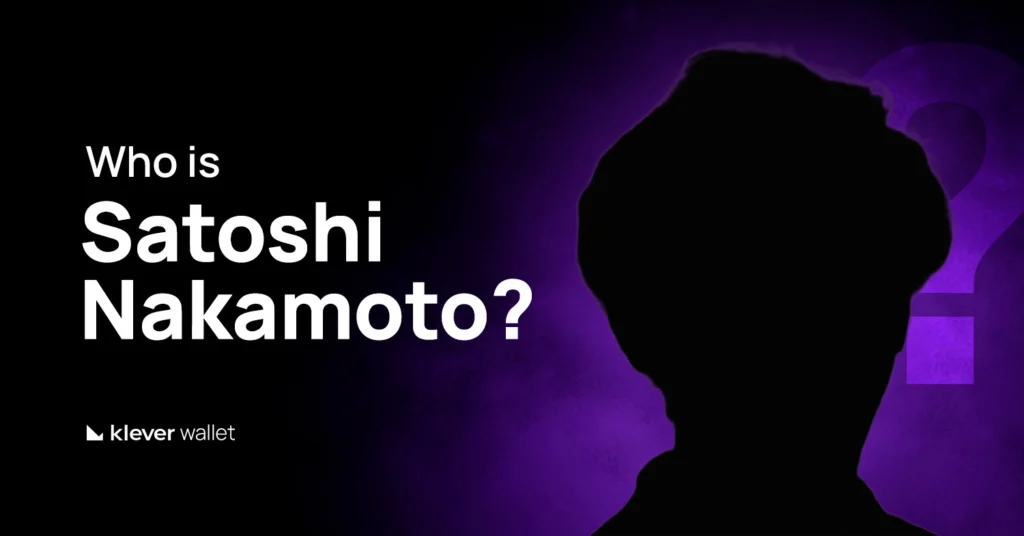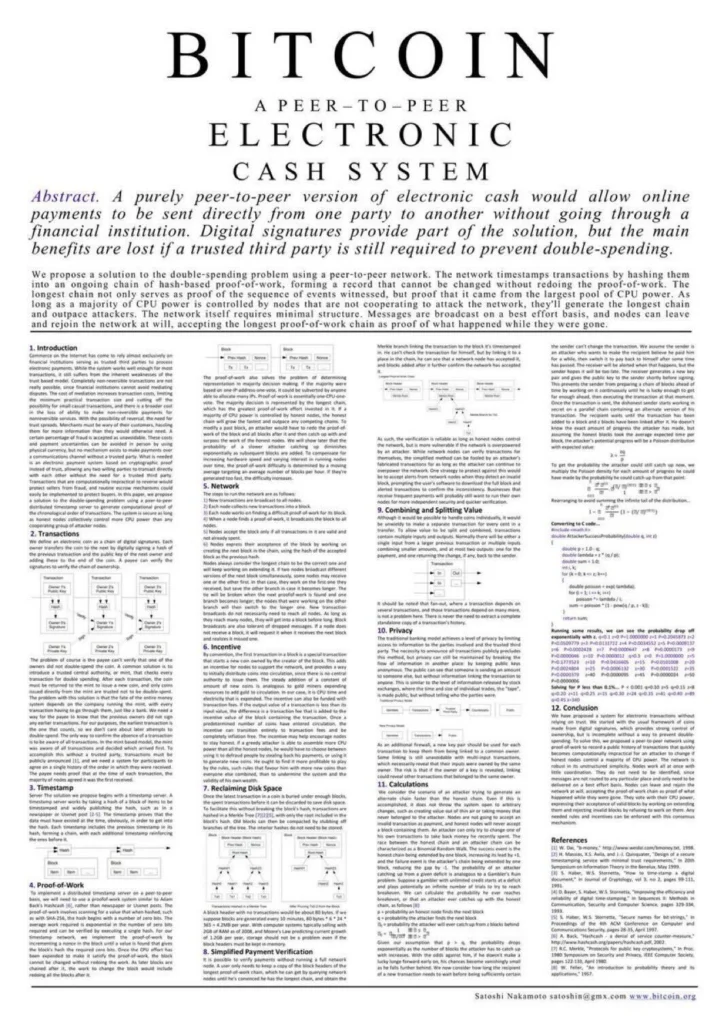
In a world accustomed to great names behind great inventions, one remains shrouded in complete mystery: Satoshi Nakamoto. No one knows whether it’s a man, a woman, a group of people — or even an identity carefully crafted never to be revealed.
More than a decade after the publication of the whitepaper that introduced Bitcoin to the world, the mystery surrounding their true identity remains intact. What is beyond question, however, is the impact of their creation: understanding who Satoshi Nakamoto was means delving into the origins of one of the greatest technological and financial revolutions of the 21st century.
The Origin of Satoshi Nakamoto
The story of Satoshi Nakamoto begins in October 2008, when a nine-page document titled “Bitcoin: A Peer-to-Peer Electronic Cash System” was shared on an online cryptography mailing list.
In this whitepaper, Satoshi described a revolutionary idea — a digital currency that could be transferred directly between people without the need for banks, governments, or intermediaries. It introduced a trustless system where every transaction would be verified by a decentralized network of computers.
Just a few months later, on January 3, 2009, Satoshi mined the first Bitcoin block, known as the Genesis Block. Embedded in this block was a message taken from a British newspaper headline:
“The Times 03/Jan/2009 Chancellor on brink of second bailout for banks.”
That small detail wasn’t random — it symbolized the motivation behind Bitcoin: to create an alternative to the traditional financial system, one built on transparency, autonomy, and cryptographic security.
Between 2009 and 2010, Satoshi worked relentlessly on the project. He fixed bugs, improved the software, and exchanged messages with other early contributors on online forums like Bitcointalk.org. These discussions formed the foundation of Bitcoin’s open-source community.
Then, sometime in 2010, Satoshi gradually faded from public view.
He handed over control of the Bitcoin code repository to other developers, stopped replying to emails, and eventually vanished — leaving behind not only the code that powered Bitcoin, but also one of the greatest mysteries in modern technology.
The Whitepaper That Started It All

The Bitcoin whitepaper, published by Satoshi Nakamoto in October 2008, became one of the most influential documents in the history of technology. In just nine pages, it introduced a practical solution to one of computer science’s longest-standing challenges — the double-spending problem.
Before Bitcoin, every attempt to create digital money faced the same flaw: there was no way to guarantee that someone couldn’t copy and reuse the same digital coin twice. Traditional financial systems solved this by depending on central authorities like banks to verify transactions. Satoshi took a radically different approach.
He proposed a peer-to-peer network where transactions would be validated collectively by independent participants — not by a single institution. This network, now known as the blockchain, records every transaction in chronological order, creating a permanent and tamper-resistant public ledger.
Through this system, Satoshi introduced three revolutionary principles that define Bitcoin’s architecture and philosophy:
- Decentralization: No central authority issues or manages Bitcoin. Power is distributed among thousands of nodes worldwide.
- Transparency: Every transaction is visible on the blockchain, ensuring trust through open verification.
- Scarcity: Bitcoin’s supply is capped at 21 million coins, making it digitally scarce and resistant to inflation.
By combining cryptography, game theory, and distributed consensus, Satoshi transformed a theoretical concept into a working digital economy. The whitepaper didn’t just launch Bitcoin — it laid the foundation for the entire blockchain revolution that followed.
Disappearance and Legacy of Satoshi Nakamoto
In 2010, after handing over control of Bitcoin’s repository to developer Gavin Andresen, Satoshi’s messages stopped.
His final known communication was in April 2011. Since then, no one has heard directly from him — or her — again.
Yet, his influence remains everywhere:
- Every blockchain project builds on Satoshi’s foundation.
- Bitcoin’s core principles — freedom, privacy, and trustless systems — continue to guide crypto innovation.
Theories About Satoshi Nakamoto’s Identity
No one knows for certain who Satoshi Nakamoto is. Several theories have emerged:
- Hal Finney – One of the earliest Bitcoin contributors and the first person ever to receive BTC from Satoshi.
- Nick Szabo – Creator of Bit Gold, a concept similar to Bitcoin.
- Dorian Nakamoto – A California engineer mistakenly identified by Newsweek in 2014.
- Craig Wright – An Australian businessman who claims to be Satoshi but has not provided verifiable proof.
Linguistic analysis of Satoshi’s writings and code patterns suggests English fluency, with timestamps indicating activity consistent with U.S. time zones, not Japan — despite his online claim of living there.
Ultimately, none of the theories have been proven. Satoshi’s identity remains a carefully guarded secret — perhaps intentionally — ensuring that Bitcoin belongs to no one and everyone at once.
How Much Bitcoin Does Satoshi Nakamoto Own?
The question of how much Bitcoin Satoshi Nakamoto owns has fascinated crypto analysts, investors, and researchers for over a decade. Since Bitcoin’s launch in January 2009, several blockchain forensics studies have tried to estimate the amount mined by its mysterious creator — and the results are astounding.
According to blockchain research, Satoshi mined between 750,000 and 1.1 million BTC in the early days of the network.
- Nasdaq cites this range, supported by studies analyzing early mining patterns.
- The figure comes mainly from the Patoshi Pattern — a recognizable mining fingerprint discovered by researcher Sergio Demian Lerner in 2013. This pattern identified a single miner who consistently produced blocks between blocks 1 and 54,316, strongly believed to be Satoshi.
If accurate, this means the creator of Bitcoin could theoretically control up to US$ 130 billion worth of BTC (based on a price of around US$ 123,000 per coin). That would place Satoshi among the wealthiest individuals on the planet — on paper.
Why Satoshi’s Coins Have Never Moved
Despite holding what could be a life-changing fortune, none of Satoshi’s wallets have ever shown activity beyond the early mining years.
No transfers, no exchanges, no public spending — nothing.
This absolute silence has become part of Bitcoin’s mythology.
There are several theories about why:
- Principle: Satoshi may have wanted Bitcoin to exist free of founder influence.
- Security: Moving such coins would immediately expose them to global scrutiny.
- Legacy: Keeping them untouched reinforces Bitcoin’s image as a neutral, decentralized system.
The Mystery Behind the “Untouched Fortune”
Satoshi’s decision — or inability — to access these coins raises philosophical questions:
Was he a visionary uninterested in profit, or did he simply vanish before Bitcoin gained value?
Regardless, the untouched nature of these addresses contributes to Bitcoin’s credibility. It shows that the network’s integrity and independence outweigh any individual’s financial power.
Why Does Satoshi Nakamoto Still Matters?
Understanding Satoshi’s work is key to understanding why Bitcoin exists.
His creation reshaped:
- Finance — introducing decentralized money.
- Technology — inspiring blockchain ecosystems.
- Society — redefining trust in digital systems.
Every wallet, blockchain, or DeFi protocol owes its existence to the foundation Satoshi built in 2009.
Satoshi Nakamoto’s anonymity fuels both curiosity and respect.
He, she, or they disappeared — yet left a self-sustaining global network that doesn’t need its creator.
Bitcoin continues to evolve, proving that code, community, and cryptography can outlive even the person who started it all.




